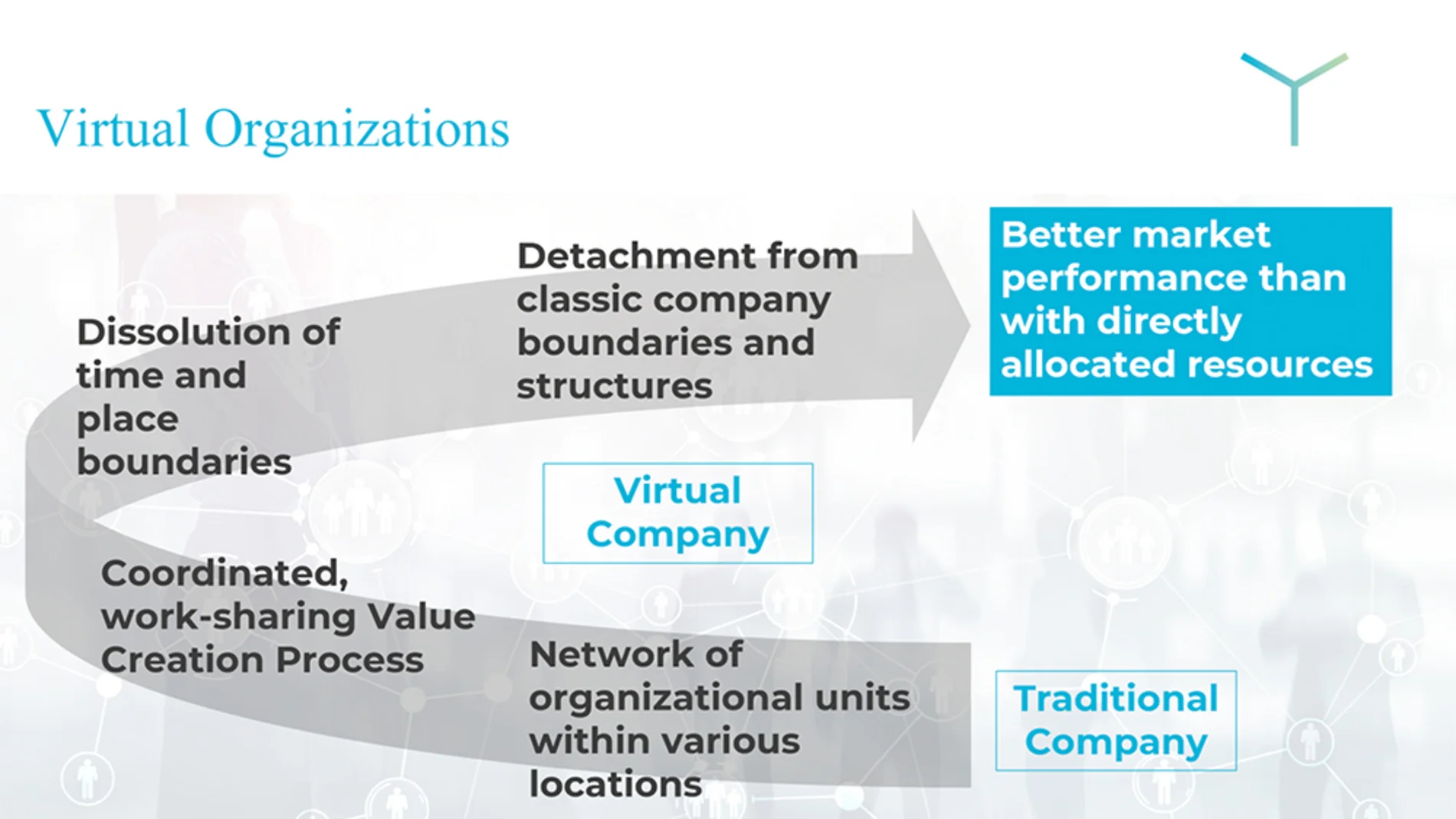COVID-19 and the ensuing necessity to work away from a main office is accelerating an established trend toward virtual organizations. It is a perfect breeding ground for growing our virtual organization experiences. In my blog post on Managing areas of responsibilities, I’ve described the future implications on leadership.
In today’s post, I’d like to take you on a journey into virtual organizations. Let’s examine what’s behind this ubiquitous buzzword. I’ll also be providing some practical tips for your own virtual ride.

Traveling back in time: dreaming of virtual organizations
The vision of creating virtual organizations first appeared in the 1990s. Scientists as well as practitioners identified virtual organizations as the enterprise of the future. Inspired by Bill Davidov’s and Michael S. Malone’s book The Virtual Corporation, many people dreamed of dynamic, self-organized networks that would bundle the competencies of various business partners and appear as one organization toward the customer. At that time, great hope was placed in information technology as an enabler for this development. But when the dotcom bubble burst at the beginning of the 2000s, that was the end of that dream for a while.
The virtual platform business model
The bubble on the financial markets may have burst, but digitalization continued to thrive. Companies that survived this time are still driving entire industries. The most famous examples are Google, Amazon and E-Bay. These organizations are all based on a virtual platform approach, an ecosystem that facilitates exchange between various user groups. Low transaction costs are their key to success.
The underlying creed is that “What a company owns matters less than what it can connect.” Virtual organization platforms have long become reality. Younger platform companies like Uber and Airbnb have further sparked the development away from traditional business models toward more disruptive models. This trend is likely to continue.
B2B jumps on the platform
This platform trend has spilled over to the B2B markets. Germany’s Handelsblatt speaks about The Amazon for business customers, mentioning XOM as an example. XOM’s vision is to become a digital ecosystem hub for the materials industry. The company behind XOM is Klöckner & Co, an established German steel wholesaler. In an interview for our book titled Because leadership has to change, Klöckner CEO Gisbert Rühl describes his vision: a platform for all players in the materials industry, including competitors. Meanwhile, his vision has become a reality.
Not without my vision
Speaking of visions: Successful virtual platform enterprises are high-tech, user-friendly and extremely customer-focused. But they have another common feature: a strong, attractive vision of the future. The best virtual platform is useless if you’re not clear on what you want to achieve with it.
Here’s some hands-on advice – three criteria your platform should fulfill:
- Magnet: Bring at least two different user groups on board. Generally, this means suppliers and customers.
- Toolbox: A successful platform provides the required tools that facilitate the interaction of different user groups.
- Matchmaker: Matching users are found through data matching.
Even if you haven’t actually implemented a platform business model, you can still utilize the platform logic for your company.
Not all three criteria have to be fulfilled simultaneously. User reviews can serve as a magnet for customers. Product recommendations based on previous purchases work as a matchmaker. User forums have a toolbox as well as a magnet effect. For more information and examples, read this article on Dissecting Amazon’s platform play.
You can also initiate a virtual platform within your company. This may help to effectively promote and accelerate change. My blog post on The change platform explains how.
Remember to first develop the vision of your platform before you implement it.
Back to the future: The virtual organization is alive!
It’s been 20 years since the dotcom bubble. Information technology has changed dramatically. Smartphones with all their apps & co. are but one example. The mobile Internet has grown significantly in terms of bandwidth and speed. 5G is bringing another boost.
So what happened to the concept of virtual organizations from the 1990s? The short answer is: It’s become reality! Above all, we’ve seen a consistent virtualization of the value chain.
Virtual organizations: Puma
The German sporting goods manufacturer Puma is known as a prototype of the virtual organization. The company now concentrates only on its core competencies – development, design and marketing. Other areas such as production, logistics and sales are outsourced to 80 virtually interconnected partner companies worldwide.
State-of-the-art communication enables the company to be independent of location. Instead of being limited to an eight-hour day at company headquarters, Puma runs its business around the clock, around the globe. This means that services are provided independent of location as well as time.
Puma’s transformation was not a question of whether but merely a question of how. It was an ailing company that hadn’t seen the trend of time. For Puma, a radical change toward a virtual organization was simply a matter of survival. And that’s what every company should have in mind: Are we still well positioned in how we work and create value? Framework conditions may change faster than you think. 2020 has been a perfect example of that.
The journey from home office to a virtual organization
When employees work from home or from different company locations, there is a virtual network of location-distributed organizational units. This can be considered the smallest form of a virtual organization.
A full-blown version is a time-bound network of independently functioning units. They are set up, expanded, reduced or dissolved based on the number of orders and projects in the pipeline.
The core question becomes: Where will a specific required task be performed in order to make it most effective? In a highly dynamic and ever-changing environment, this can be a key success factor.
The following chart illustrates the development of a virtual organization as a continuum.

Ready for a new culture?
Using modern information technology in a smart way simply won’t suffice. A virtual organization also needs the right culture. Many companies consider the current state of virtual collaboration from home a deviation from the old normal. Their goal is to return to normality and work from a specific location. Home office solutions used to be a concession to employees, not an operational tool. To this day, many companies still have a culture based on physical presence and supervision. One of the reasons for this is that old leadership styles still prevail.
In my view, this is short-sighted. If we begin to learn the culture of virtual collaboration now, we can use it to be more flexible in a dynamic environment. So don't wait. Start your journey now!
My practical tips for your journey toward a virtual organization
1.
Ask your employees what they like and don’t like about virtual collaboration. Derive specific measures from their answers.
2.
Integrate your customers and suppliers in the process. How are they experiencing these changed working conditions? Which conclusions can you draw for your virtual collaboration?
3.
Identify reasons why your company should move toward a virtual organization. Take a look beyond the horizon at developments in the market, customer behavior and other industries.
4.
Create a vision: What would your company look like as a virtual organization? Even if this is still wishful thinking at the moment, you will have created a vision of the future that you can approach step by step.
Bon voyage!
Would you like my support on specific approaches that will make your company more successful?
Send me a message!